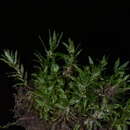Biology
provided by Arkive
Mosses, hornworts and liverworts form a group of plants called bryophytes (1). Bryophytes lack many of the more complex structures of the higher plants, such as a vascular system, and flowers. They do not have roots, instead they have structures called 'rhizoids' which absorb water and anchor the plant to the substrate. All bryophytes have an interesting life cycle consisting of two main parts, called the gametophyte and sporophyte generations (3). Plants that are in the gametophyte stage can reproduce sexually. Male organs (antheridia) produce antherozoids which move to the female organs (archgonia). Fertilisation occurs and a 'sporophyte' develops, this structure remains attached to the plant. The sporophyte releases spores which disperse and develop into a new plant (3). In the lesser smoothcap, sporophytes are produced very rarely in winter (1).
Conservation
provided by Arkive
A UK Biodiversity Action Plan Priority Species, the lesser smoothcap has a Species Action Plan which outlines and coordinates proposed conservation measures (2). This plan aims to maintain the strong populations of this species (2). A survey of the sites is needed to assess the status of this endangered moss (1).
Description
provided by Arkive
Lesser smoothcap is a dull-green moss that forms patches of single, unbranched and upright shoots that have narrow leaves with toothed edges (1). The leaves curl up when the moss becomes dry (1). Mosses are broadly divided into two main types, called 'acrocarpous' and 'pleurocarpous' mosses. This species is an 'acrocarpous' moss (1); these mosses tend to have erect shoots that have limited growth, and terminate in male and/or female sexual structures. Side branches allow further growth to occur (3). Close examination allows this species to be distinguished from the other members of the genus Atrichum, as it has smaller spores and cells (1)
Habitat
provided by Arkive
Found in woodland rides and paths growing on bare, fairly acidic, damp, shaded, loamy or sandy soil. It has also been recorded from roadside banks, abandoned sandpits and open grassland heaths (1).
Range
provided by Arkive
Most UK records of this species are concentrated in the High Weald in Sussex and Kent (2), but it has not been seen at a third historic site in this area since 1950 (1). A few scattered records are known from southern Scotland and south Wales (2). Outside of the UK this moss has a broad distribution across Europe, reaching as far east as western Asia. It has also been recorded from Iceland, Madeira, the Azores (2), Turkey, Japan and eastern and central parts of North America (1).
Status
provided by Arkive
Classified as Endangered in Great Britain (1).
Threats
provided by Arkive
The threats facing this species are poorly understood, but it is thought that decline in coppicing in woodlands as well as the neglect of woodland rides and paths may be factors (2).
Comments
provided by eFloras
Atrichum angustatum is a small, dioicous species, easily distinguished by its narrow, channeled leaves with numerous, tall, wavy lamellae, and small, ± isodiametric, bulging-mammillose, papillose leaf cells. A characteristic habitat for this species is mounds of subsoil thrown up by the roots of fallen trees. All Atrichum species develop cuticular papillae to some degree, but in no case are they as evident as in this species. Plants growing in more humid situations tend to be less strongly papillose. The distinction between A. angustatum, with smooth cells, and A. xanthopelma and A. macmillanii, with papillose cells, is without merit. The leaves of the type of A. angustatum (from South Carolina) are strongly papillose.
- license
- cc-by-nc-sa-3.0
- copyright
- Missouri Botanical Garden, 4344 Shaw Boulevard, St. Louis, MO, 63110 USA
Description
provided by eFloras
Plants small, dull yellowish green, sometimes with a reddish cast. Stems 1-2 cm. Leaves 4-8 × 0.4-0.8 mm, narrowly ligulate to oblong-lanceolate above, concave, strongly undulate, with prominent teeth in oblique rows on abaxial surface corresponding to the undulations, margins with mostly double teeth; costa subpercurrent, toothed on the back above; lamellae 6-9(-12), with wavy margins, 5-10(-15) cells high, widely spreading and covering much of the leaf surface; median cells of lamina 8-17(-19) µm wide, ± isodiametric with firm walls, bulging-mammillose on adaxial surface, usually with prominent minute, rounded or striate papillae, especially on the abaxial surface. Sexual condition dioicous; male plants about same size or smaller than females, the perigonial bracts broad, forming conspicuous antheridial buds, often with more than one bud in sequence per plant. Seta 1-3 cm, erect, typically 1 per perichaetium. Capsule 3-7 × 0.3-0.6 mm, narrowly cylindric, usually ± straight to somewhat curved, suberect or inclined. Spores 11-16 µm.
- license
- cc-by-nc-sa-3.0
- copyright
- Missouri Botanical Garden, 4344 Shaw Boulevard, St. Louis, MO, 63110 USA
Synonym
provided by eFloras
Polytrichum angustatum Bridel, Muscol. Recent., suppl. 1: 79. 1806; Atrichum angustatum var. plurilamellatum (Jennings) Frye; A. macmillanii (Holzinger) Frye; A. papillosum (Jennings) Frye; A. xanthopelma (Müller Hal.) A. Jaeger & Sauerbeck
- license
- cc-by-nc-sa-3.0
- copyright
- Missouri Botanical Garden, 4344 Shaw Boulevard, St. Louis, MO, 63110 USA
Atrichum angustatum
provided by wikipedia EN
- license
- cc-by-sa-3.0
- copyright
- Wikipedia authors and editors
Atrichum angustatum: Brief Summary
provided by wikipedia EN
Atrichum angustatum is a species of mosses belonging to the family Polytrichaceae.
It is native to Eurasia and Northern America. It is rare in Iceland, being found at only two locations at is locally listed as a vulnerable species (VU).
- license
- cc-by-sa-3.0
- copyright
- Wikipedia authors and editors

